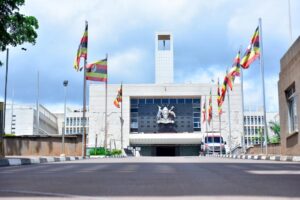
By Our Writer
Kampala
Parliament approved a record Shs10.5 trillion in new loans just within three days pushing the country’s total public debt to Shs126.7 trillion.
That total public debt is equivalent to 56% of the national GDP (Shs226.3 trillion) — far above the 50% debt-to-GDP threshold recommended for low-income countries.
The literally means that if Uganda was someone’s home, that home will be now thriving on debts after failing to live with in its own means of income.
The parliamentary approvals, granted between Tuesday, October 28 and Wednesday, October 30, 2025, came just before Parliament adjourned sine die.
According to Media reports, the wave of approvals marks one of the largest single-week borrowing authorizations in Uganda’s recent fiscal history.
HOW THE LOAN WAS BROKEN DOWN
1_ USD 200 million from the World Bank’s IDA for the Public Investment and Asset Management for Growth and Resilience Program (PIMPLUS).
2_EUR 188.18 million from the African Development Bank and EUR 28.31 million from the African Development Fund for Busega–Mpigi Expressway construction.
3_EUR 9.4 million from Unicredit Bank Austria for the Mbale Oncology Centre.
4_USD 336.5 million from the Islamic Development Bank (IsDB) for Arua Oncology Centre and Mbale Radiotherapy Equipment.
5_USD 20 million from the Arab Bank for Development in Africa (BADEA) for the Nebbi–Goli Road (16km).
6_EUR 115.9 million from Standard Chartered Bank for the Critical Oil Roads Package 6B including Karugutu–Ntoroko Road (68km).
7_USD 121.9 million from the African Development Fund for the South Sudan–Uganda Power Interconnection Project.
8_EUR 192.9 million from Citibank for Enhancing Agricultural Production, Quality and Standards for Market Access (Phase I).
USD 1.34 billion from the World Bank, plus USD 328.3 million in grants, for NUSAF IV, ULEARN, and UCMID programs.
9_EUR 230.4 million from Citibank for Jinja–Mbulamuti–Kamuli–Bukungu Road (127km) and Jinja City Roads (10km).
10_EUR 342.5 million from Standard Chartered Bank for the Karuma–Tororo 400kV Transmission Line and Ntinda Substation Project.
In total, the Shs10.5 trillion represents about 14.6% of the 2025/26 national budget of Shs72.1 trillion, signaling the government’s continued dependence on borrowing to fund infrastructure and close fiscal gaps.
As of June 2025, Uganda’s public debt stood at Shs116.2 trillion (51.3% of GDP) — a sharp 26.2% increase from Shs89.5 trillion in 2024. The new borrowing pushes external debt to around Shs66 trillion, while domestic debt stands at Shs60.3 trillion.
Economists have raised concerns about debt sustainability, noting that debt servicing already consumes over 30% of recurrent expenditure, crowding out vital spending on healthcare, education, and social services.
The IMF and other fiscal observers have repeatedly cautioned that Uganda’s growing reliance on external loans could strain future budgets and limit fiscal flexibility.
With this latest borrowing spree, Uganda’s debt trajectory continues to rise steeply — highlighting the government’s challenge of balancing infrastructure ambitions with sustainable development.


